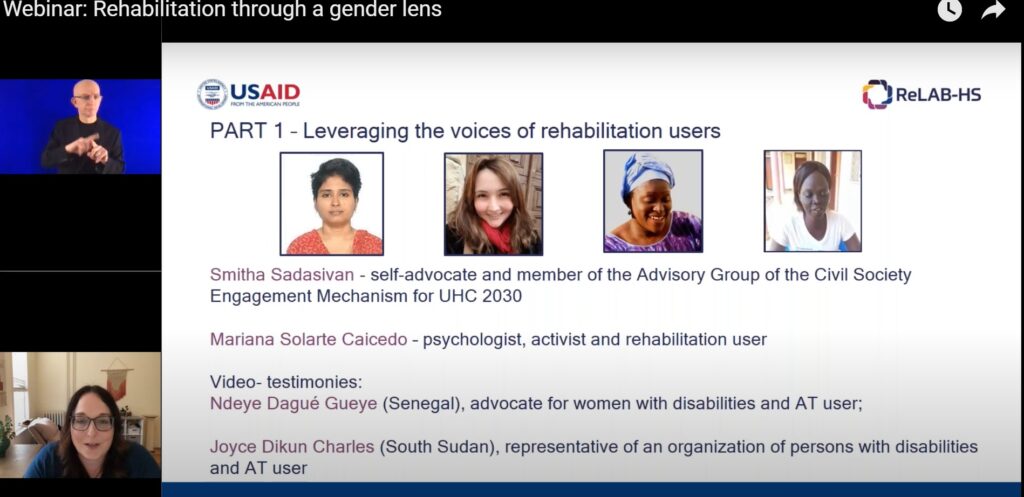
By Diana Shcherbinina for ReLAB-HS
Rehabilitation is an essential part of universal health coverage, along with promotion of good health, prevention of disease, treatment, and palliative care. Rehabilitation helps people to be as independent as possible in everyday activities. 2.4 billion people globally need rehabilitation and the need for rehabilitation worldwide is predicted to increase due to changes in the health and characteristics of the population. For example, people are living longer, but with more chronic disease and disability. In some low- and middle-income countries, more than 50 percent of people do not receive rehabilitation services. For women and girls, the unmet need of rehabilitation is even greater.
Gendered barriers exist across the key dimensions of health (and rehabilitation) services: availability, accessibility, affordability, and acceptability. Disability, ethnicity, race, socioeconomic status, and lower educational levels can further affect participation or compound bias in referrals and assessment, and throughout the pathway. The webinar Rehabilitation through a gender lens was held by ReLAB-HS to discuss key findings and recommendations from the recently published advocacy factsheet ‘Rehabilitation through a gender lens,’ which was guided by a scoping review conducted within the ReLAB-HS Gender Equality and Social Inclusion (GESI) Working Group. The webinar provided a platform for dialogue between rehabilitation users, health professionals, civil society, and policymakers. The webinar was hosted by Rosemary Morgan, ReLAB-HS GESI Coordinator.
In the first part of the webinar “Leveraging the Voices of Rehabilitation Users” we heard from rehabilitation users Smitha Sadasivan (India) – self-advocate and member of the Advisory Group of the Civil Society Engagement Mechanism for UHC 2030; and Mariana Solarte Caicedo (Columbia) – psychologist, activist. Through video-testimonies we also heard from Ndeye Dagué Gueye (Senegal), advocate for women with disabilities, and Joyce Dikun Charles (South Sudan), representative of an organization of persons with disabilities. They emphasized the lack of rehabilitation providers who are women and gender minorities , lack of caregiving services, inaccessibility of transport and infrastructure, as well as lack/absence of adopted information to different people’s needs. Nowadays, most of the information we get is from electronic devices and the internet, and a lot of people from low- and middle-income countries (LMICs) either do not have devices or do not know how to get digital information.
In the second part of the webinar “Addressing Challenges and Implementing Recommendations” panelists discussed key recommendations for integrating a gender lens into rehabilitation. We heard from Angela Nakafeero, Commissioner of Gender & Women Affairs, Uganda; Ghulam Nabi Nizamani, General Director at the Department of Empowerment of Persons with Disabilities in Sindh Province, Pakistan; Lillian Asiimwe, Gender & Social Inclusion Officer for ReLAB-HS in Uganda and Sabina Ciccone, Technical Unit Manager at Humanity & Inclusion in Myanmar. Gertrude Oforiwa Fefoame, member of the UN Committee on the Convention of the Rights of persons with disabilities, Global Advisor Manager for Social Inclusion at Sightsavers and Member of the Board of the Ghana Federation of Disability Organisations joined via video recording.
Each panelist reflected on the six recommendations from the fact sheet:
They talked about the recommendations they found most relevant in their context, based on their experience, and why, and what should be done to translate this recommendation into action and reality.
Angela Nakafeero emphasized that the paradigm should be changed to ensure that women and girls take care of themselves, since they usually prioritize their family member’s needs. Ghulam Nabi Nizaman explained that assistive technology should become a part of Pakistan’s health system as now they are provided only for the purpose of social security, charity, or philanthropic reasons. Lillian Asiimwe explained that the government in Uganda has already rolled out the Health Management Information System, where data, disaggregated by sex and gender, is being collected, which provides a template for rehabilitation data collection as more and more countries understand that the absence of disaggregated data forms gaps in the health system as well as in other spheres. Conflicts and destabilization lead to the breakdown of all systems. A complicated situation in Myanmar has evolved into a protracted crisis. Sabina Ciccone discussed the complicated situation which has evolved in Myanmar which has led to massive protests and movement of medical personnel as they help people injured in protests.
“We really need to ensure the availability of a multidisciplinary gender‑inclusive and gender‑responsive rehabilitation workforce, ensuring rehabilitation as a topic is included in all workforce education efforts” – Maryam Mallick, Technical Advisor at the World Health Organization in Pakistan.
Maryam Mallick, Technical Advisor at the World Health Organization in Pakistan, provided a summary of the webinar and emphasized that rehabilitation must become a political priority and that it must be gender‑responsive. We need to strengthen legislation, plan actions, track progress, and create technical committees or workgroups. Maryam talked about the WHO’s Rehabilitation in Health System Guide for Action, which is a roadmap for countries to develop a strategic plan, to increase quality, accessibility, and effectiveness of rehabilitation and assistive technology.
As countries continue to strengthen rehabilitation within health systems it is important that all efforts are gender responsive. This cannot be done, however, if the gender barriers to rehabilitation access and use are not identified and addressed. The advocacy factsheet ‘Rehabilitation through a gender lens’ will help decision- and policy-makers in these efforts.